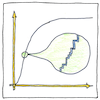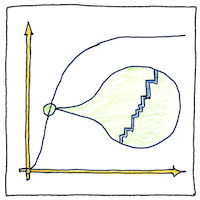Heinrich Barkhausen
electromagnetism

|
Barkhausen effect
The quantum of magnetization in ferromagnetic material is not the atom with its two tiny poles but irregular bunches of atoms that align together called domains. Heinrich Barkhausen found that changes of magnetization did not happen continuously, but in random steps as each magnetic domain resists being realigned or is caught on defects in the crystal lattice, but then suddenly gives way, one after another, producing irregular avalanches of magnetic noise.
Before Barkhausen
Operators using Marconi’s magnetic detector had to endure the crackling, breathing of Barkhausen noise, but without knowing what caused it. Marconi’s detector was discontinued around 1912.
Explaining
In this one the physicists were behind the inventors, explaining, not predicting. But once inventors learned the science, they could use it to test metals for imperfections and mechanical stress.



Magnetic domains are too small and too much alike to see without a Kerr microscope, and domains are not the same as crystalline grains in a metal, but wouldn’t ancient makers of sword blades have had ideas about the alignments of iron crystals?
See also in The book of science:
Readings in wikipedia: